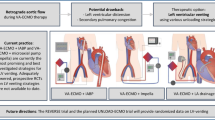Abstract
Purpose
The aim of this study was to evaluate the indications for pulmonary resection (lobectomy) in patients with increased total pulmonary vascular resistance (TPVR) during a preoperative unilateral pulmonary artery occlusion (UPAO) test. According to our previous report, the feasibility of performing lobectomy in patients with a high risk of cardiopulmonary complications is determined on the basis of the increase in TPVR after 15 min of obstruction during the UPAO test (occluded TPVR).
Methods
A total of 19 high-risk [occluded TPVR ≥700 dynes/s/cm−5/m2 (dynes)] patients who underwent lobectomy or pneumonectomy were studied and a detailed analysis of postoperative cardiopulmonary complications was performed. The subjects were divided into four groups based on the occluded TPVR (700–799 dynes, 800–899 dynes, 900–999 dynes, or ≥1000 dynes) to compare the incidence of postoperative complications.
Results
Two patients died after surgery. One of them had an occluded TPVR >1000 dynes and died 313 days after right upper lobectomy; the other had an occluded TPVR of 783 dynes and died 20 days after right pneumonectomy. Postoperative cardiopulmonary complications occurred in 6 of 19 patients (31.6%), and all three patients with an occluded TPVR ≥900 dynes developed cardiopulmonary complications.
Conclusion
Limited surgery should be performed in patients with an occluded TPVR ≥900 dynes.
Similar content being viewed by others
References
Deslauriers J, Ginsberg RJ, Dubois P, Beaulieu M, Goldgerg M, Piraux M. Current operative morbidity associated with elective surgical resection for lung cancer. Can J Surg 1989;32:335–339.
Harpole DH, DeCamp MM, Daley J, Hur K, Henderson WG, Khuri SF, et al. Prognostic models of thirty-day mortality and morbidity after major pulmonary resection. J Thorac Cardiovasc Surg 1999;117:969–979.
Nezu K, Kushibe K, Tojo T, Takahama M, Kitamura S. Recovery and limitation of exercise capacity after lung resection for lung cancer. Chest 1998;113:1511–1516.
Bobbio A, Chetta A, Carbognani P, Internullo E, Verduri A, Sansebastiano G, et al. Changes in pulmonary function test and cardio-pulmonary exercise capacity in COPD patients after lobar pulmonary resection. Eur J Cardiothorac Surg 2005;28:754–758.
Nagamatsu Y, Maeshiro K, Kimura YN, Nishi T, Shima I, Yamana H, et al. Long-term recovery of exercise capacity and pulmonary function after lobectomy. J Thorac Cardiovasc Surg 2007;134:1273–1278.
Olsen GN, Block AJ, Swenson EW, Castle JR, Wynne JW. Pulmonary function evaluation of lung resection candidates: prospective study. Am Rev Respir Dis 1975;111:379–387.
Weisman IM. Cardiopulmonary exercise testing in the preoperative assessment for lung resection surgery. Semin Thorac Cardiovasc Surg 2001;13:116–125.
Nagamatsu Y, Shima I, Hayashi A, Yamana H, Shirouzu K, Ishitake T. Preoperative spirometry versus expired gas analysis during exercise testing as predictors of cardiopulmonary complications after lung resection. Surg Today 2004;34:107–110.
Nagamatsu Y, Terazaki Y, Muta F, Yamana H, Shirouzu K, Ishitake T. Expired gas analysis during exercise testing prepneumonectomy. Surg Today 2005;35:1021–1025.
Carlens E, Hanson HE, Nordenstrom B. Temporary unilateral occlusion of the pulmonary artery. J Thorac Surg 1951;22:527–536.
Sloan H, Morris JD, Figley M, Lee R. Temporary unilateral occlusion of the pulmonary artery in the preoperative evaluation of thoracic patients. J Thorac Surg 1955;30:591–597.
Nakata T, Nitta S. Research progress in the pathophysiology of the lung. In: Gekagaku taikei. Tokyo: Nakayama-Shoten; 1975. p. 203–208 (in Japanese).
Nagamatsu Y, Maeshiro K, Kashihara M, Iwasaki Y, Shima I, Yamana H, et al. Selection of pulmonary resection procedures to avoid postoperative complications. Surg Today 2007;37:202–206.
Borg G. Perceived exertion as an indicator of somatic stress. Scand J Rehabil Med 1970;2:92–98.
Pauwels RA, Buist AS, Calverley PM, Jenkins CR, Hurd SS. GOLD scientific committee: global strategy for the diagnosis, management, and prevention of chronic obstructive pulmonary disease-NHLBI/WHO global initiative for chronic obstructive lung disease (GOLD) workshop summary. Am J Respir Crit Care Med 2001;163:1256–1276.
Author information
Authors and Affiliations
Corresponding author
Rights and permissions
About this article
Cite this article
Nagamatsu, Y., Ohkita, A., Kimura, N.Y. et al. Retrospective investigation of pulmonary resection in patients with high total pulmonary vascular resistance during preoperative unilateral pulmonary artery occlusion. Gen Thorac Cardiovasc Surg 57, 244–249 (2009). https://doi.org/10.1007/s11748-008-0384-y
Received:
Accepted:
Published:
Issue Date:
DOI: https://doi.org/10.1007/s11748-008-0384-y




